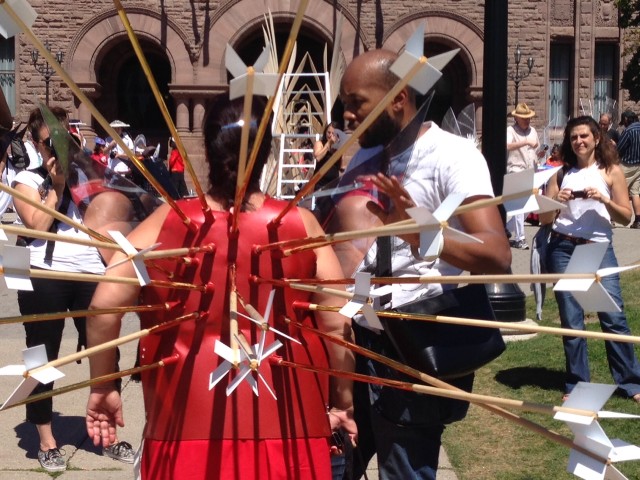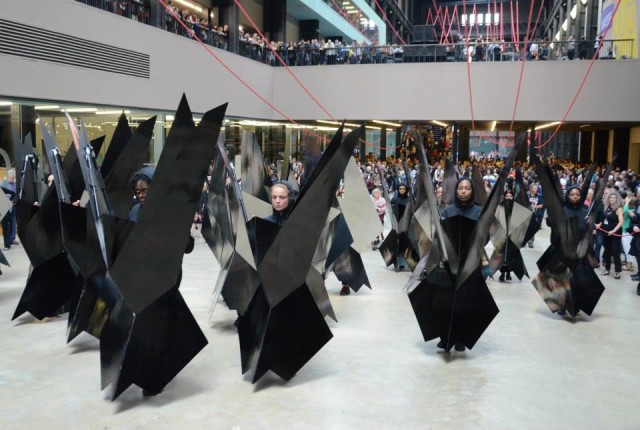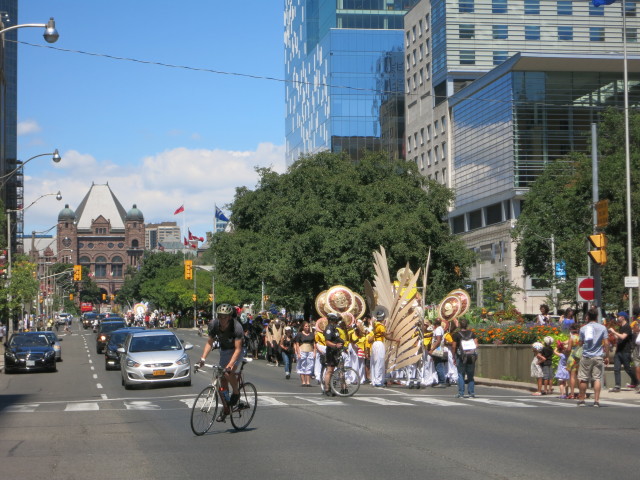Last Sunday afternoon, in front of the historic Ontario Legislative Building in Toronto’s Queen’s Park, the different sections of a street procession had gathered, waiting. Even though the atmosphere thrummed with an excitable confusion among its just over two hundred masqueraders in anticipation of undertaking a two-and-a-half kilometer parade route along University Avenue to City Hall, it all threatened to wilt under the blaze of the hot sun. Volunteers scurried back and forth down the line, spraying with water bottles those wearing outsized circular masks and seemingly precarious, ten-foot high netted sculptural wings.
These were the marchers in “Ring of Fire”, a large-scale participatory art project by Trinidadian artist Marlon Griffith, staged in the midst of the city’s Parapan Am Games, a key qualifying round for the 2016 Rio Paralympics. Here, a spectrum of differently-abled bodies participated in the event—a mix of young and old, with a number of manual and power wheelchair users in variations of seated costumed dress. Billed as an artwork for Torontonians by Torontonians, Griffith’s collaborators included persons with disabilities, capoeira athletes, young spoken word poets from the city’s underserved neighborhoods, various community arts organizations, and the Mississaugas of New Credit First Nation. Two years in the making, the project was commissioned by the Art Gallery of York University (AGYU), and curated by its assistant director, Emelie Chhanghur, who is known for her process-based curatorial projects involving community outreach and gallery “in-reach”.
Based on the Anishinaabe Seven Grandfather Teachings, “Ring of Fire” saw each teaching influence the concept and aesthetics of its corresponding processional section. (The structure can be directly attributed to the Mississaugas’ involvement; tellingly, they hold traditional land ties to the Greater Toronto Area.) The Nibwaakaawin (Wisdom) faction, for instance, was led by Elder Duke Redbird, who rode on a 10-foot chariot of bent wood and aluminum framing; he was followed by an orator (played by a spoken word poet from the Jane-Finch neighborhood), an entourage and “public” wearing gold-inflected cardboard paper masks and sunny yellow detachable shirt fronts, representing the life-giving sun and lunar cycle. Since Nibwaakaawin means both wisdom and intelligence in the Anishinaabe language, they led the entire procession, and its players, in a sort of meta commentary, were Griffith’s lead collaborators in “Ring of Fire”. Redbird was the one who taught Griffith about the Seven Teachings, the entourage was played by Art Starts, one of the community art organizations. (Over the course of this summer, participants in its “Sew What?!” fashion program were responsible for making the “Ring of Fire” costumes.) “Ring of Fire”, then, was the culmination of two different but similar collaborative art-making processes: carnival performance as an increasingly significant but previously marginalized contemporary art practice of the Caribbean and its greater diaspora, and the curatorial activist strategies of an educational institution.
Marlon Griffith began his career as a Carnival designer. His use of mas, the masquerade tradition of Trinidad Carnival, provides an organizational structure for how he collaborates with the different communities he engages. (Disclosure: I worked briefly with Griffith briefly last summer when he was in the research phrase of his AGYU commission, providing curatorial support during his public studio residency at the Drake Hotel.) His commissions mindfully adapt these parade-type performances to dwell on the experiences of its local collaborators: last year’s “No Black in the Union Jack”, commissioned by the Tate Modern during London’s Notting Hill Carnival, for instance, took inspiration in the 2011 London summer riots. Paraders marched in futuristic mirrored riot gear, literally reflecting back upon its spectators the experience of living in a surveillance police state. “Positions + Power”, a commission for the CAC exhibition En Mas’, was staged during the 2014 Trinidad Carnival and had masqueraders interacting with a mobile surveillance tower, playing out the police booths present during Carnival time. “Mas,” writes Trinidadian writer Nicholas Laughlin, “uses spectacle not merely to amaze an audience, but to tell stories, ask questions, make claims: about the community, its history, its fears and dreams.”

Disability activist Wanda FitzGerald, who was the Sentinel of the Minaadendamowin (Respect) faction. Image credit: Rea McNamara
When I arrived at Queen’s Park that afternoon, I saw Griffith agilely moving between different masqueraders for final touches and adjustments, like fixing the fit of a red plexiglass breastplate stabbed with gilded arrows at the back. The message was visceral: blood, killing, the walking dead. (And, intentional: this was the costume worn by disability activist Wanda FitzGerald, who was the Sentinel of the Minaadendamowin (Respect) faction. All the members of the Respect faction were clothed in red, while a majority wore masks made of custom-designed cardboard in a trickster blue and red.) Indeed, many of the costumes contained references to warrior dress: a bronze Roman cavalry face mask alongside an iridescent aboriginal mask mounted above a wearer’s shoulders, like a totem pole; a group in black, protected with what looked like molded wooden samurai vests. In the distance, one could hear the beginning sounds of drum, beating like a steady heartbeat. It felt as if all these factions were preparing to march towards a battlefield. It was us against—well, whom, exactly?
Marlon Griffith’s work is continuing a strain of mas that is totally absent in today’s Carnivals, which are frequently disregarded as a form of “pretty mas”: bikinis, beads and feathers, an exploited mass spectacle. In Toronto, this is especially prevalent: our Carnival, formerly known as Caribana, was taken over by a banking institution—it’s legal name for the past four years has been the “Scotiabank Caribbean Carnival”, but many still refer to it as Caribana in defiance to this questionable naming right—and has largely been stripped of its meaning as a subversive and political form of street theatre for the sake of generating city tourism dollars. It was significant, to paraders and spectators, that the “Ring of Fire” parade route was the former parade route of Caribana. What use to march down the city’s downtown core has, for the past twenty years, been largely confined to the Canadian National Exhibition (CNE) grounds. In the age of #BlackLivesMatter, Caribana and other North American carnivals struggle with funding issues, and the over-policing of its attendees. It was a visceral, psycho-geographic experience: looking upward at the office and apartment towers, imagining what it would have been like to see revellers waving their flags from the open windows.
“Ring of Fire”, then, was a bold reclaiming of the downtown streets by its participating marginalized communities; a chance for its paraders to reflect back, protected by outsized costumes, their lived experiences. The participation of persons with disabilities was especially potent, especially in how their assistive devices were transformed: one all-white section was led by a figure whose walker was extended higher with an armature covered with densely stenciled translucent spikes, casting a moiré shadow upon its entourage, who wore exaggerated cardboard paper masks echoing the same patterns. The lack of distinction between design for disability and design in general was profound to witness.
A challenge, however, with “Ring of Fire” was the periodic intrusions of its documentation. Carnival performance is ephemeral in its nature: it’s a pics-or-it-didn’t-happen scenario. All that’s left are the pieces of costume. With the AGYU gearing for an exhibition of Griffith’s work in the fall, they were aggressive in documenting the street procession: at one point along University Avenue, I witnessed for the first time a drone slowly helicopter up to the sky, precariously floating high above, being piloted next to me by a videographer crew. For a procession whose paraders clearly outnumbered its attendees, the constant circling of cameras at the edges was jarring, and reminding me of how fraught public demonstration is today: police and citizens wearing body-cameras, the visibilities of these sometime violent exchanges. It also reminded me of the legacy of the 2010 G20 protests, which was the scene of one of the largest mass arrests in Canadian history.
But “Ring of Fire” is evocative in the survival strategies mapped out by masquerade: the opportunity to roleplay our conflict with institutions and powers. Near the end of the procession, I witnessed a young poet, wearing a riot gear mask, speak these words into a megaphone: “let the world watch you—you are the artist of the body.” “Ring of Fire,” then, was a rare Toronto public artwork: a distilling of the buried, lived histories of marginalization into a simulacrum of conflict.






Comments on this entry are closed.